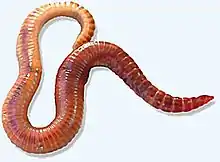Eisenia fetida
Eisenia fetida (older spelling: foetida), known under various common names such as manure worm,[2] redworm, brandling worm, panfish worm, trout worm, tiger worm, red wiggler worm, etc., is a species of earthworm adapted to decaying organic material. These worms thrive in rotting vegetation, compost, and manure. They are epigean, rarely found in soil. In this trait, they resemble Lumbricus rubellus.
| Eisenia fetida | |
|---|---|
 | |
| Scientific classification | |
| Kingdom: | Animalia |
| Phylum: | Annelida |
| Class: | Clitellata |
| Order: | Opisthopora |
| Family: | Lumbricidae |
| Genus: | Eisenia |
| Species: | E. fetida |
| Binomial name | |
| Eisenia fetida | |
They have groups of bristles (called setae) on each segment that move in and out to grip nearby surfaces as the worms stretch and contract their muscles to push themselves forward or backward.
Eisenia fetida worms are used for vermicomposting of both domestic and industrial organic waste.[3][4][5] They are native to Europe, but have been introduced (both intentionally and unintentionally) to every other continent except Antarctica. Tiger worms are also being tested for use in a flushless toilet, currently being trialled in India, Uganda and Myanmar.[6]
Eisenia fetida also possess a unique natural defense system in their coelomic fluid: cells called coelomocytes secrete a protein called lysenin, which is a pore-forming toxin (PFT), which is able to permeabilize and lyse invading cells. It is best at targeting foreign cells whose membranes contain significant amounts of sphingomyelin. (Lysenin is also toxic to organisms lacking sphingomyelin in their cell walls, including B. megaterium, though the pathway is not understood). [7]. Red wiggler is reddish-brown color and has a small ring shape entire body and have a yellowish tail.[8]
Odor
When roughly handled, a redworm exudes a pungent liquid, thus the specific name foetida meaning "foul-smelling". This is presumably an antipredator adaptation.

Related species
Eisenia fetida is closely related to E. andrei, also referred to as E. f. andrei. The only simple way of distinguishing the two species is that E. fetida is sometimes lighter in colour. Molecular analyses have confirmed their identity as separate species, and breeding experiments have shown that they do produce hybrids. [9]
Reproduction
As with other earthworm species, E. fetida is hermaphroditic, and uniparental reproduction is possible, even if usually the reproduction is between copulating individuals.[10] The two worms join clitella, the large, lighter-colored bands which contain the worms' reproductive organs, and which are only prominent during the reproduction process. The two worms exchange sperm. Both worms then secrete cocoons which contain several eggs each. These cocoons are lemon-shaped and are pale yellow at first, becoming more brownish as the worms inside become mature. These cocoons are clearly visible to the naked eye. At 25°C E. fetida hatches from its cocoon in about 3 weeks. [11]
Life expectancy
The life expectancy of Eisenia fetida under controlled conditions varies, according to different authors, between one and five years. [12]
References
- "Eisenia foetida". Fauna Europaea. 2004.
- "Catalogue of Life : Eisenia fetida (Savigny, 1826)". www.catalogueoflife.org. Retrieved 2021-01-26.
- Albanell, E.; Plaixats, J.; Cabrero, T. (1988). "Chemical changes during vermicomposting (Eisenia fetida) of sheep manure mixed with cotton industrial wastes". Biology and Fertility of Soils. 6 (3). doi:10.1007/BF00260823. ISSN 0178-2762. S2CID 21470644.
- Orozco, F. H.; Cegarra, J.; Trujillo, L. M.; Roig, A. (1996). "Vermicomposting of coffee pulp using the earthworm Eisenia fetida: Effects on C and N contents and the availability of nutrients". Biology and Fertility of Soils. 22 (1–2): 162–166. doi:10.1007/BF00384449. ISSN 0178-2762. S2CID 25060696.
- Maboeta, M.S.; Rensburg, L.van (2003). "Vermicomposting of industrially produced woodchips and sewage sludge utilizing Eisenia fetida". Ecotoxicology and Environmental Safety. 56 (2): 265–270. doi:10.1016/S0147-6513(02)00101-X. ISSN 0147-6513. PMID 12927558.
- "Testing the "Tiger Toilet"". US AID. May 26, 2016.
- Bruhn, Heike; Winkelmann, Julia; Andersen, Christian; Andrä, Jörg; Leippe, Matthias (2006-01-01). "Dissection of the mechanisms of cytolytic and antibacterial activity of lysenin, a defence protein of the annelid Eisenia fetida". Developmental & Comparative Immunology. 30 (7): 597–606. doi:10.1016/j.dci.2005.09.002. ISSN 0145-305X. PMID 16386304.
- "Red wiggler Body appearance".
- Plytycz, Barbara; Bigaj, Janusz; Panz, Tomasz; Grzmil, Paweł (2018-09-21). "Asymmetrical hybridization and gene flow between Eisenia andrei and E. fetida lumbricid earthworms". PLOS ONE. 13 (9): e0204469. Bibcode:2018PLoSO..1304469P. doi:10.1371/journal.pone.0204469. PMC 6150523. PMID 30240427.
- Domínguez, Jorge; Velando, Alberto; Aira, Manuel; Monroy, Fernando (2003-01-01). "Uniparental reproduction of Eisenia fetida and E. andrei (Oligochaeta: Lumbricidae): evidence of self-insemination: The 7th international symposium on earthworm ecology · Cardiff · Wales · 2002". Pedobiologia. 47 (5): 530–534. doi:10.1078/0031-4056-00224. ISSN 0031-4056.
- Neuhauser, Edward F.; Hartenstein, Roy; Kaplan, David L. (August 1980). "Growth of the Earthworm Eisenia Foetida in Relation to Population Density and Food Rationing". Oikos. 35 (1): 93–98. doi:10.2307/3544730. Retrieved 2020-10-14.
- Venter, J.M.; Reinecke, A.J. (1987-01-29). "The life-cycle of the compost worm Eisenia fetida (Oligochaeta)". African Zoology. 23 (3): 161–165. doi:10.1080/02541858.1988.11448096. Retrieved 2020-10-14.